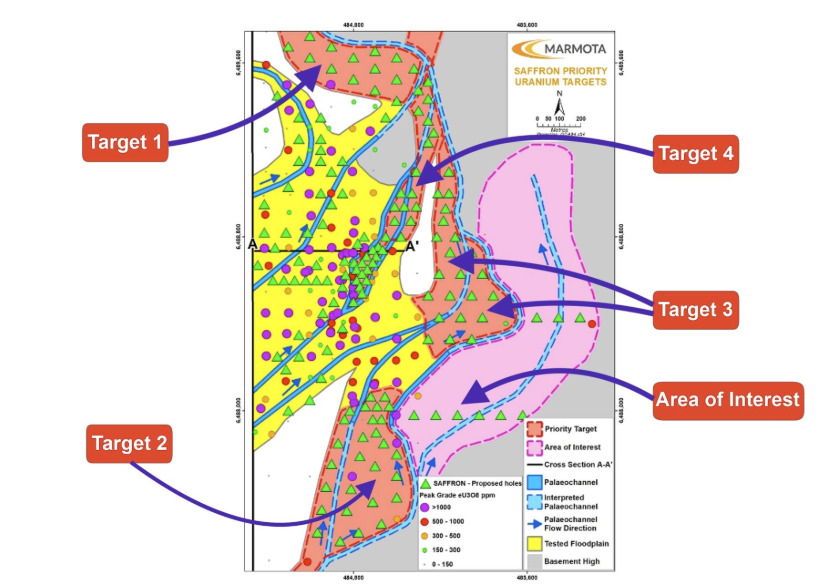With drilling on the way, can $50mn SA uranium play Marmota follow in the footsteps of $2bn neighbour Boss?

Marmota wants to follow the path of its neighbour Boss Energy at tenements that bookend the $2bn player’s Honeymoon mine. Pic: Getty Images.
- Marmota has designed a drill program for the Saffron uranium resource area at Junction Dam
- The program has been designed to substantially increase the existing uranium resource
- 164 drill holes have been designed to infill the current Saffron uranium resource as well as test four high priority targets
Special report: As demand for uranium goes nuclear, Marmota will scale up drilling at its Junction Dam project in South Australia to infill its 5.4Mlb Saffron resource and test four priority targets across one of South Australia’s most attractive uranium exploration licences.
Marmota’s (ASX:MEU) Junction Dam project in South Australia bookends both sides of the palaeochannel that runs through Boss Energy’s (ASX:BOE) Honeymoon mine, a short 18km to the west.
With the Saffron deposit boasting an average grade of 557ppm U3O8, MEU says the project is similar in grade, scale and potential as Honeymoon which produced its first drum of uranium last week.
Beyond the inferred Saffron resource, Marmota boasts an exploration target of 22-33Mlb at 400-700ppm U3O8 incorporating the Saffron, Bridget and Yolanda targets. While more dispersed, the upper end of that target would be similar in scale to Boss’ Honeymoon.
MEU’s goal is to grow the existing uranium resource at Saffron, and then expand the Junction Dam resource further by bringing in the Bridget and Yolanda uranium deposits, which are yet to be included in the project’s resource.
Drilling high priority targets for uranium
This drilling program has been designed by uranium expert Mark Couzens to test the four targets at Saffron generated from a stratigraphic and mineralisation review completed last year.
The four targets were identified to the north, east and south of the 5.4Mlb Saffron via stratigraphic modelling and the interpretations of EM/gravity images where the geology is favourable for the deposition of uranium mineralisation.
This exploration work also identified six main uranium-bearing palaeochannels in the Saffron deposit, which are all open for further mineralisation and will be tested in the upcoming program.

Proposed drill holes near the Saffron resource area. Pic: Marmota Ltd
MEU says the holes will be tested using a rotary mud drill rig with downhole geophysical probes suitable for uranium exploration.
Each completed drill hole will be geophysically logged for Gamma radiation and resistivity down the length of the drill hole to determine lithology and correlating stratigraphy, as well as mineralised intervals for the calculation of U3O8 grades.
Drilling program
Target 1 is at the junction of 5 of the 6 uranium-bearing palaeochannels that appear to merge alongside the Willyama Basement. A large bend in the basement has been highlighted and is highly likely to create a well-developed floodplain to the SW of the paleochannels. This would be an ideal location for high-grade uranium to precipitate, MEU says. Around 18 drill holes have been designed to test Target 1.
Target 2 is on the southern side of the Saffron deposit.
Drillholes in this section has shown high grade uranium present on 3 of the 4 flood plains adjacent to the paleochannels with the remaining floodplain currently untested.
The program here will comprise 29 drill holes to determine whether the paleochannels joint up with the Yolanda prospect to the south.
On the eastern edge of Saffron is Target 3, which has had very limited drilling to date.
The stratigraphic interpretation and EM modelling suggests there will likely be bends in the paleochannels where well-developed floodplains should have formed.
Six drill holes are planned to test whether the three uranium-bearing paleochannels have been interpreted to run along the Willyama Basement.
About 81 drill holes will test Target 4, within the current resource area.
This target is ~600m long by 150m wide with the potential to host high grade uranium mineralisation and is largely untested.
Area of interest
MEU’s ‘Area of Interest’ is a large region interpreted as a topographic low from the stratigraphic model.
The company believes it boasts potential to contain paleochannels and uranium mineralisation associated with floodplains adjacent to the paleochannels. Nine drill holes are planned to test this target.
In addition to the new targets, MEU plans to drill 14 holes into the Saffron resource itself.
This article was developed in collaboration with Marmota, a Stockhead advertiser at the time of publishing.
This article does not constitute financial product advice. You should consider obtaining independent advice before making any financial decisions.
Related Topics

UNLOCK INSIGHTS
Discover the untold stories of emerging ASX stocks.
Daily news and expert analysis, it's free to subscribe.
By proceeding, you confirm you understand that we handle personal information in accordance with our Privacy Policy.








